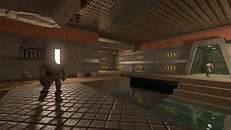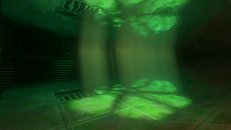Tuesday, November 26th 2019

Quake II RTX Updated with More Sharper Textures and Better Lighting Effects
NVIDIA today released a major update to Quake II RTX that add even more eye-candy to the game, leveraging RTX. Quake II RTX, promoted by NVIDIA, is a playable tech-demo for its RTX real-time ray-tracing technology that's based on a classic 3D game so it runs on nearly all DXR-compatible graphics cards (GeForce GTX 10-series, 16-series, and RTX 20-series). It comes with id Software's shareware 1st episode content, although you can add your own licensed game data for the full game.
With version 1.2, NVIDIA added support for a boatload of modern technology, beginning with support for dynamic resolution scaling. Much like watching online videos with resolution toggle set to "auto" (which adjusts resolution based on your Internet bandwidth), dynamic resolution scaling adjusts the rendering resolution of your game on the fly in pursuit of a frames-per-second target. NVIDIA also remastered several textures of the game, increasing texture detail. Over 400 textures have been redone by NVIDIA, adding detail. Support is added for multiple reflection/refraction bounces, which makes it possible to create a "hall of mirrors" effect. NVIDIA implemented light shafts or god rays throughout the game, including underwater light shafts. Light shafts also get reflected off certain metal or glass surfaces. NVIDIA also improved the AI denoiser for the game. Metal and glass surfaces are made to appear more photo-real thanks to denoiser improvements. Find many other technical changes in the official change-log below.DOWNLOAD: Quake II RTX v1.2
New Features:
With version 1.2, NVIDIA added support for a boatload of modern technology, beginning with support for dynamic resolution scaling. Much like watching online videos with resolution toggle set to "auto" (which adjusts resolution based on your Internet bandwidth), dynamic resolution scaling adjusts the rendering resolution of your game on the fly in pursuit of a frames-per-second target. NVIDIA also remastered several textures of the game, increasing texture detail. Over 400 textures have been redone by NVIDIA, adding detail. Support is added for multiple reflection/refraction bounces, which makes it possible to create a "hall of mirrors" effect. NVIDIA implemented light shafts or god rays throughout the game, including underwater light shafts. Light shafts also get reflected off certain metal or glass surfaces. NVIDIA also improved the AI denoiser for the game. Metal and glass surfaces are made to appear more photo-real thanks to denoiser improvements. Find many other technical changes in the official change-log below.DOWNLOAD: Quake II RTX v1.2
New Features:
- Added support for dynamic resolution scaling that adjusts rendering resolution to meet an FPS target.
- Added support for multiple reflection or refraction bounces.
- Added light coloring by tinted glass.
- Added support for security camera views on some monitors in the game.
- Added god rays in reflections and refractions, improved god rays filtering.
- Added a spatial denoiser for the specular channel.
- Added support for loading custom sky (portal) light meshes from.obj files, and added portal light definitions for many maps in the base game.
- Added triangular lights for laser beams: https://github.com/NVIDIA/Q2RTX/issues/43
- Added "shader balls" to the shipping builds.
- Added cvar 'pt_accumulation_rendering_framenum' to control how many frames to accumulate in the reference mode.
- Added cvar 'pt_show_sky' to make analyzing skybox geometry easier.
- Fixed the stutter caused by Steam overlay by updating to the latest version of SDL2.
- Fixed Stroggos atmospheric scattering (sky color) and overall sky brightness.
- Fixed light scattering on the clouds.
- Fixed the issue with overexposed player setup screen: https://github.com/NVIDIA/Q2RTX/issues/18
- Fixed the sudden darkening of the screen: https://github.com/NVIDIA/Q2RTX/issues/26
- Fixed the "PF_centerprintf to a non-client" warnings that happened on the "command" map when the computers are blown up, instead of informative on-screen messages.
- Fixed missing GI on reflections of the first person model.
- Improved image quality and temporal stability of reflections and refractions by computing correct motion vectors for reflected surfaces and surfaces visible through flat glass.
- Disabled the pixel jitter when temporal AA is turned off.
- Added sample jitter to the spatial denoiser to improve the noise patterns that appear after light invalidation.
- Improved image stability around blinking lights by using the light intensities from the previous frame on gradient pixels.
- Improved stability of indirect lighting from sphere lights by limiting their contribution.
- Added storage scaling for all lighting channels to avoid color quantization.
- Fixed flickering that happened when the number of dynamic lights changes.
- Improved sharpness of textured glass and similar transmissive effects by passing them around the denoiser.
- Added multiple importance sampling of specular reflections of direct lights.
- Replaced sphere lights that were used for wall lamps (mostly in the "train" map) with polygon lights to reduce noise.
- Added an upper limit on sky luminance to avoid oversampling the sky in shadowed areas and thus reduce noise from direct lights.
- Added light sampling correction based on statistical per-cluster light visibility. The idea is, if we see that a light is usually not visible, let's not sample it so much.
- Metals are now rendered much better thanks to the denoiser and BRDF improvements.
- Over 400 textures have been adjusted or repainted.
- Removed the nonlinear transform from emissive textures, and reduced the negative bias applied to them.
- Force light materials to be opaque to make the laser lights in mine maps appear in reflections.
- Restore specular on materials with roughness = 1, but make specular on rough dielectrics much dimmer.
- Fixed scaling of diffuse and specular reflections: https://github.com/NVIDIA/Q2RTX/issues/37
- Fixed relative brightness and spotlight terms for different light types.
- Hemisphere sampling for indirect diffuse tuned to make the results better match the cosine-weighted sampling in reference mode.
- Trace more specular rays for shiny metals that do not need indirect diffuse lighting.
- Fixed the misdirection of second bounce lighting into the diffuse channel when the light path starts as specular on the primary surface: https://github.com/NVIDIA/Q2RTX/issues/25
- Replaced regular NDF sampling for specular bounce rays with visible NDF sampling: https://github.com/NVIDIA/Q2RTX/issues/40
- Tuned fake specular to be closer to reference specular.
- Added normalization of normal map vectors on load to avoid false roughness adjustments by the Toksvig factor.
- Improved roughness correction to not happen on texture magnification, and to better handle cases like zero roughness.
- Fixed the computation of N.V to avoid potential NaNs: https://github.com/NVIDIA/Q2RTX/issues/23
- Removed the multiplayer specific sun position setting, and changed the remaining setting to be morning by default.
- Changed the default value of texture LOD bias to 0 for extra sharpness.
- Use nearest filter for upscaling from 50% resolution scale (a.k.a integer scaling).
- Made the brightness of sprites, beams, particles, smoke, and effects like quad damage be similar to overall scene brightness, to avoid having them washed out under direct sunlight.
- Made the explosions and other sprites appear in low-roughness specular reflections.
- Changed the flare lights to be derived from the flare model entity instead of the effect event, which makes the lights follow the flares smoothly in flight, and reduces flicker that was due to frequent light creation and destruction.
- Removed insane and dead soldiers with 'nomonsters 1'.
- Random number generator now produces enough different sequences to cover thousands of frames for reference mode accumulation.
- The 'pt_direct_polygon_lights' cvar has a new meaning when set to -1: all polygon lights are sampled through the indirect lighting shader, for comparison purposes.
- Moved the first person player model a bit backwards to avoid having it block reflections.




31 Comments on Quake II RTX Updated with More Sharper Textures and Better Lighting Effects
It's also in my UT3 map collection, but it's too small for the Giant size powerups in UT3, lol.
As for the differences between version 1 and this update, I can say that the game looks better and I can see a measurable smoothness improvement.
Everyone who has an RTX card needs to grab this!
Raspberrys have little keyboard/mouse lag, compared to win7, btw.
If you bitch about game lag on a lan, or even modern broadband, it's YOU, lol.
I still remember the first time I saw a BFG rendered on a TNT card; it was F'in beautiful. :)
I'm banned (in our group) from using the railgun in Q2, Q3, and some games with the sniper rifle.
Low rate of fire guns aren't slow, if you have timing, lol.